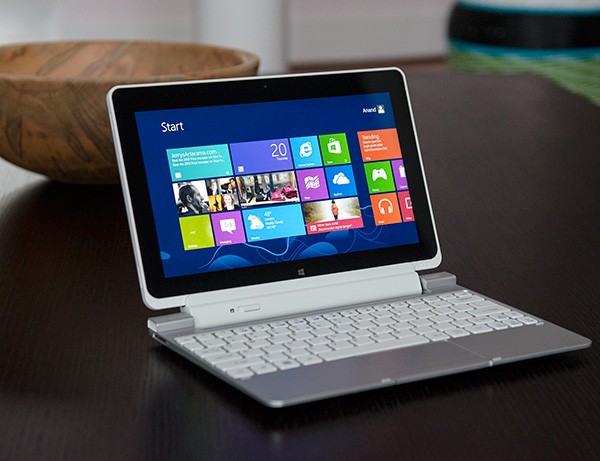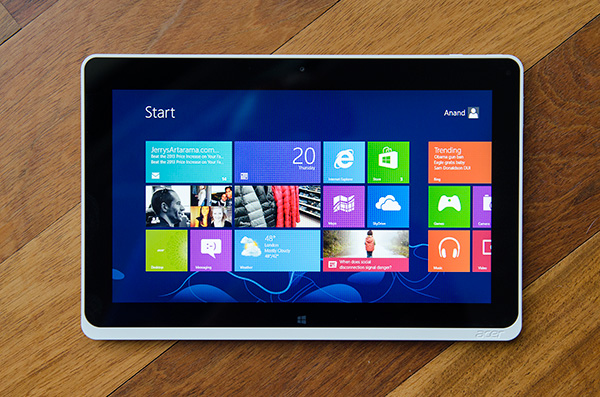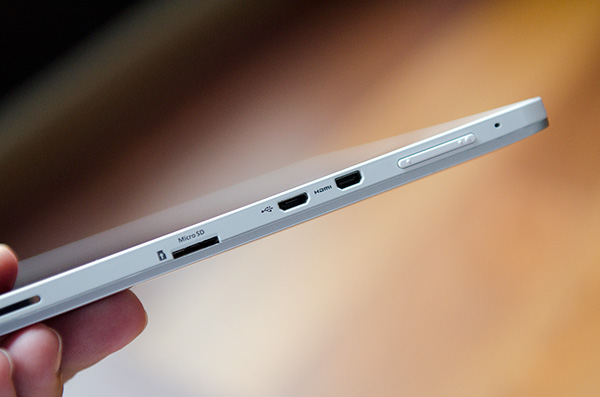The Clover Trail (Atom Z2760) Review: Acer's W510 Tested
by Anand Lal Shimpi on December 20, 2012 10:34 AM ESTMicrosoft’s Windows 8/RT launch has been a bit choppier than expected. I remember hearing rumors that the OS release could slip into next year, but it seems that the solution to the problem was to launch as devices were ready rather than delay everything. Surface was among the first out of the gate, and I was generally pleased with the tablet, but Microsoft’s partner devices have been slower to release. ASUS held its VivoTab RT launch on the same day as Surface RT, but there were many key absences from the launch week in late October.
Among those missing from launch week were any x86 Windows 8 tablets. Although for most of the year Intel had been quite confident in its Windows 8 tablet story, the fact that I had to secretly borrow one just to get some rough performance numbers in our Surface RT story was a problem.
A little over a month later and things are beginning to change. Contrary to popular belief, driver problems aren’t what kept the first Atom Windows 8 tablets out of the market at launch. A bug (not related to power management) caught several months ago caused schedules to slip by about a month and a half. Depending on whose design the OEM followed (Intel’s or their own), the implementation of the fix could come quickly or would take a bit longer. In this case, Acer and Samsung found themselves on the right side of the fence. We’ve had Atom based Windows 8 tablets from both companies for weeks now. Vivek is working on our review of the Samsung ATIV Smart PC, while I’ll kick things off with Acer’s Iconia W510.
The W510 features Intel’s Atom Z2760, the SoC more commonly associated with the codename Clover Trail. While Intel’s Core series of CPUs will be used in high-end Ultrabooks, tablets and convertibles, doing battle at the lower price points against ARM is the Z2760/Clover Trail. Down here, Intel promises all of the power efficiency of ARM, similar pricing, better performance and of course backwards compatibility with older Windows applications.
Although Intel has largely lost the advantage x86 compatibility promised to bring to the smartphone space years ago, that advantage is alive and well under Windows. With Windows RT devices, Microsoft has the somewhat difficult job of explaining that your brand new Windows device won’t run older Windows applications. For an Atom based Windows 8 platform however, that caveat just isn’t there. Meanwhile you get all of the benefits of a Windows RT device, including connected standby - a feature that won’t be present on Core based Windows 8 tablets until Haswell rolls around in the second half of 2013.
Acer’s W510 is a 10-inch Windows 8 tablet designed to compete in a market crowded by ARM based solutions running Android, iOS and Windows RT. Backwards compatibility with decades of x86 applications is a clear point of differentiation.
The W510 is available in two different capacities: 32GB and 64GB. Acer sent along a 64GB version, which is divided into a 46.6GB user partition and 11.05GB recovery partition. Of that 46.6GB that you get to begin with, nearly 13GB is taken up by Windows, leaving you around 30GB free to begin with. This isn’t anything unusual for folks buying a Mac or PC, but if you’re comparing to lightweight mobile OSes you’re going to end up with substantially less usable storage than is advertised.
While Microsoft has definitely help cut down on the amount of bloatware installed on Windows 8 systems from the factory, there are still some culprits. Acer ships McAfee Internet Security trial-ware on the W510 by default). Spotify comes pre-loaded on the machine, as are direct links to Amazon and Ebay for some reason. The tradeoff in buying a Windows 8 tablet instead of an ARM based Windows RT tablet is that you don’t get Office Student/Home Edition 2013 for free. Acer makes it easy for you to get an Office 2010 trial, but that’s about it.
| Tablet Specification Comparison | ||||||||
| Acer W510 | Apple iPad 4 | Google Nexus 10 | Microsoft Surface RT | Samsung Ativ Smart PC | ||||
| Dimensions | 10.2 x 6.6 x 0.3" | 9.5 x 7.31 x 0.37" | 10.39 x 6.99 x 0.35" | 10.81 x 6.77 x 0.37" | 11.97 x 7.46 x 0.39" | |||
| Display | 10.1-inch 1366 x 768 IPS | 9.7-inch 2048 x 1536 IPS | 10.1-inch 2560 x 1600 PLS | 10.6-inch 1366 x 768 PLS | 11.6-inch 1366 x 768 PLS | |||
| Weight | 1.27 lbs | 1.44 lbs (WiFi) | 1.33 lbs | 1.5 lbs | 1.64 lbs | |||
| Processor | Intel Atom Z2760 (2 x 1.8GHz Atom, PowerVR SGX 545) |
Apple A6X (2 x Swift, PowerVR SGX 554MP4) |
Samsung Exynos 5 Dual |
NVIDIA Tegra 3 |
Intel Atom Z2760 (2 x 1.8GHz Atom, PowerVR SGX 545) | |||
| Connectivity | WiFi | WiFi , Optional 4G LTE | WiFi | WiFi | WiFi , Optional 4G LTE | |||
| Memory | 2GB | 1GB | 2GB | 2GB | 2GB | |||
| Storage | 32-64GB | 16GB—64GB | 16GB or 32GB | 32GB or 64GB | 64GB | |||
| Battery | 27.0Wh | 42.5Wh | 33.75Wh | 31.5Wh | 30.0Wh | |||
| Starting Price | $499 | $499 | $399 | $499 | $599 | |||
Although the official MSRP of the W510 is $599, you’ll find the 32GB model at $499 and the 64GB model will set you back another $50 on top of that. Each capacity is available as a standalone tablet or bundled with the keyboard dock.
Like Microsoft’s Touch/Type Covers for Surface, the W510’s keyboard dock isn’t cheap. Acer lists the dock at $150, and that’s roughly what I’ve seen it cost online as well. Acer will sell you the dock separately through its online store but I haven’t seen it widely available elsewhere (as of writing this the dock is out of stock at Acer as well).
Design & Build Quality
I’ve been saying this a lot privately, but Acer’s recent transformation reminds me a lot of HTC. From a design standpoint, the products Acer was putting out two years ago look absolutely nothing like what it’s shipping today. Design is now a priority at Acer, and it shows.
The W510 is all plastic and glass, but it doesn’t feel cheap. The back is an aluminum colored plastic that looks good and feels durable. Around the edge is a nice looking white plastic border and up front there’s the usual bezel and glass treatment. The result is a black frame with white border aesthetic that isn’t fundamentally new, but surprisingly rare in modern tablets.
There is a hint of flex in the chassis that’s barely enough to make a creaking sound if you try and flex the W510 at its corners. Where the back and border plastics meet isn’t particularly well engineered either – the two meet in a relatively neat fashion but run your finger along the border and you’ll feel the unevenness of the levels they meet at. None of these things are deal breakers, but Acer is playing in a different league now – with much higher standards.
The W510 is a fairly light device, at least for a 10-inch tablet. At 1.3 lbs it’s lighter than the big iPad, Surface and the Nexus 10. The weight (or lack thereof) is immediately noticeable, and makes carrying the W510 a pleasure. The 16:9 aspect ratio of the tablet isn’t the most natural unfortunately. Despite the light weight, the W510 ends up feeling a bit long as a result. There’s nothing that can be done about that unfortunately.
Optimizing around 16:9 delivers a much better video viewing and multitasking experience, at the expense of pretty much ruining portrait mode aspirations and making for a slightly awkward in-hand feel.
As the W510 is a Windows 8 tablet, it comes full of IO around the edges. On the right edge there are micro HDMI, micro USB and micro SD slots. The trio of micro IO ports are joined by a volume rocker. Up top there’s the usual 1/8” headphone jack, rotation lock slider and power/lock button. Acer’s proprietary dock/charging connector is at the bottom of the tablet.



















104 Comments
View All Comments
Pirks - Saturday, December 22, 2012 - link
I noticed serious differences in user experience between Win8 tablets bought at MS retail store and elsewhere. Anand went for the worst possible scenario and got tablet stuffed with crapware instead of buying a tablet at MS store, online or retail, WITHOUT any crapware. Guys, PLEASE bear this in mind when reading this review. THIS REVIEW IS NOT, I EMPHASIZE THIS AGAIN - _NOT_ REFLECTING REAL END USER EXPERIENCE AS ENVISIONED BY MICROSOFT. In other words, standard stores AT buys its review hardware from and MS stores are DIFFERENT things.Please, KEEP this in mind when reading this review. It is VERY likely that you will see quite a difference between experiences using two same tablets bought in different stores, MS and non-MS one. I've seen it by own eyes when for example comparing how responsive the OS is, and how stylus works on ATIV Smart PC bought on Amazon versus the one bought in MS online store.
In the end, if you buy hardware not in MS store and see some issues - quite likely it is now YOUR issue, not Microsoft's. MS is offering people retail and online stores to buy clean reliable crapware-free Windows hardware. If you buy elsewhere - you must be dumb. End of story.
Anand, please consider what I said above. I am serious, no trolling or anything here. You are one of the best tech reviewers on the net. You should strive for better, so please think again where are you buying your review units in the future. PLEASE. Thank you.
Death666Angel - Saturday, December 22, 2012 - link
I don't believe I am even dignifying your comment by commenting on my own. Firstly, I didn't find an online MS store that would sell me a W510 in Germany. Amazon.de has that. Secondly, you say it is all worse, yet you only talk about crapware, which Anand mentions in a few paragraphs but has no bearing on his conclusion or any of the real numbers (performance, battery life...). So your post screams either "bought" or "troll" to me.Ned - Saturday, December 22, 2012 - link
Ive just had confirmed that the first batch of Acer W510 optional Keyboard docks have a faulty touchpad which is fixable by any Acer service centre.All new batches from Acer have this now fixed.
Also, if you have one of the original first production W510, make sure you update the BIOS which is available on the Acer website.
powerarmour - Sunday, December 23, 2012 - link
And yet again Intel fail to deliver a quality GPU driver for PowerVR series hardware, how many times will customers be forced to put up with this mess?The reason why a Tegra 3 is more responsive is that at least Nvidia know how to write a driver that isn't a buggy mess, even the fact that Clover Trail is x86 means little at this level of dire performance, what the hell are you going to run on it that you can't already do on a WinRT platform?
agentsmithitaly - Sunday, December 23, 2012 - link
Dear AnandI know it has been already already debated, but measurement units are quite inconsistent in Anandtech's articles.
Sometimes they report both Celsius and Fahrenheit for temperatures, as well as inches and millimeters for length measurements, in this case we see imperial units for dimensions and weight comparision, dock and tablet weight in grams, millimeters for keyboard keys. Of course it's perfectly fine to express display size, or storage unit size in inches as it is the de-facto standard.
Is it possible to have International system of units on all articles? Not only for the international visitors I'm sure Anandtech has, but also because this is technology website, which I think it could be considered as science. And scientists use metrical units, including NASA ones. You remember what happened to the Mars Climate Orbiter, right?
Apart this, keep up the good work guys! And Merry Christmas to all!
yannigr - Monday, December 24, 2012 - link
We NEED AMD solutions. Pity AMD is for far behind. A tablet with for balanced hardware would have been great.zeo - Monday, December 31, 2012 - link
Yes, though AMD is releasing the Z-60 Hondo as a stop gap for now. Being a slight update to the previous Z-01 Desna, which itself was just a more power optimized version of the C-50 Ontario.2013 though will see AMD's 28nm updates, with the newer Jaguar CPU cores.
Specifically, for tablets, the upcoming 2W max TDP SoC AMD Tamesh will be their first serious entry into the tablet market and we'll see then how they compare.
For now, the Hondo is at least a option for those who don't mind limited run time but want 3x better graphics than Clover Trail, which also puts it above Tegra 3 graphical performance, and full 64bit and better Linux support.
At 1GHz though, don't expect better CPU performance...
OBLAMA2009 - Monday, December 24, 2012 - link
i think all these windows 8 tablet/notebook thingies will be a huge fail. carrying something with all these parts isnt more convenient that just using different devices or using chromeos and doing things in the cloud. atom is a seriously damaged brand name because of low performance and this new stuff doesnt change that. finally the prices for stuff like this are ridiculous. were used to paying $350 for laptops, we arent going to pay $600 for stuff a tenth as goodzeo - Monday, December 31, 2012 - link
First, there aren't that many parts and overall it is more convenient to carry one device than multiple... especially, if your actual usage favors tablet usage most of the time.Second, people have being paying such prices for iPads for years, a lot more when you consider the cost of peripherals, and ARM has only recently gotten around the performance range of a ATOM!
Tablets are typically higher priced than laptops, though Ultrabooks puts a premium that lessens the difference a bit.
People though have and will pay for the convenience of mobility, which laptops can only be considered to be portable but not truly mobile. While tablets can provide mobile usage, along with hybrids and other solutions retaining most, if not all, of the benefits of laptops as well.
It's just that there's always compromise when going smaller and lighter, and no solution is perfect for everyone! Along with it yet being determined what size the actual market will be, as these are first gen Windows based devices and many are just waiting for the pro and second gen products.
So it's comparing apples to oranges with tablets and laptops, different solution for people with different needs!
Btw, even Chromebooks require a certain level of performance. Cloud doesn't run everything and you can't always have a high speed connection, which is one of the reasons why Chrome OS has a native client and support for hardware acceleration!
The Cloud isn't that reliable yet either and not everything can be replaced by Cloud apps yet. Though such services are getting better and help alleviate the limitations of these mobile devices.
mhaager2 - Monday, December 24, 2012 - link
I don't really understand all the negativity towards Win RT and the Surface RT in particular. We have an iPad3, a nexus 7, and now a surface RT in our house. Hands down I like my Surface RT the best. It is by far the best of all in terms of productivity. I like the OS a lot. Its stable, responsive, and a pleasure to use. I like the touch cover a lot. I can type well enough on it to be useful without being a hassle to lug around. I have never experienced lag with it yet.Could MS improve the Surface? Of course. A higher DPI screen would be nice. A faster CPU is always nice. A lower price would be nice. Still despite all of this I still find this the most useful tablet I have used. As far as the paucity of apps goes, I think having half a million apps in your app store means a LOT of redundancy. MS is missing some key apps for me unfortunately which means I can't go to Win8 phone yet but as long as they keep adding quality apps I think this is the platform for me going forward.